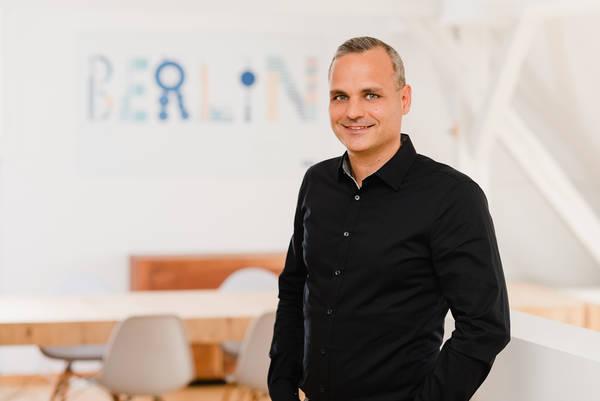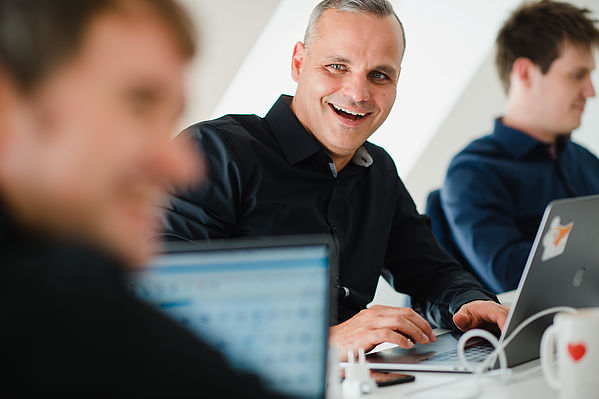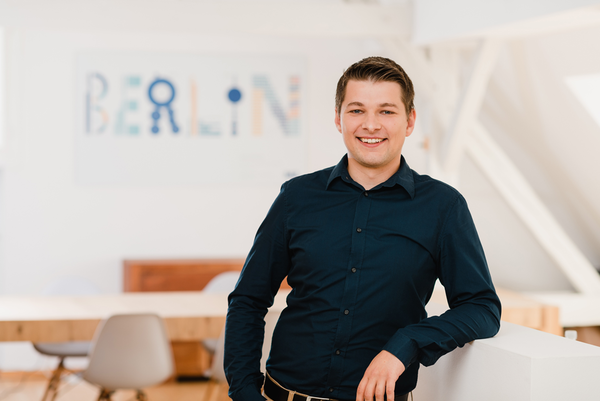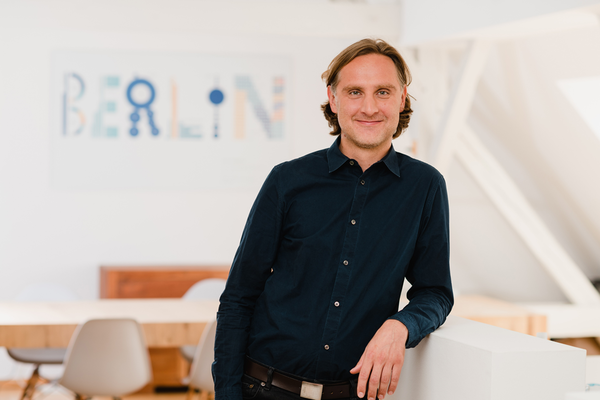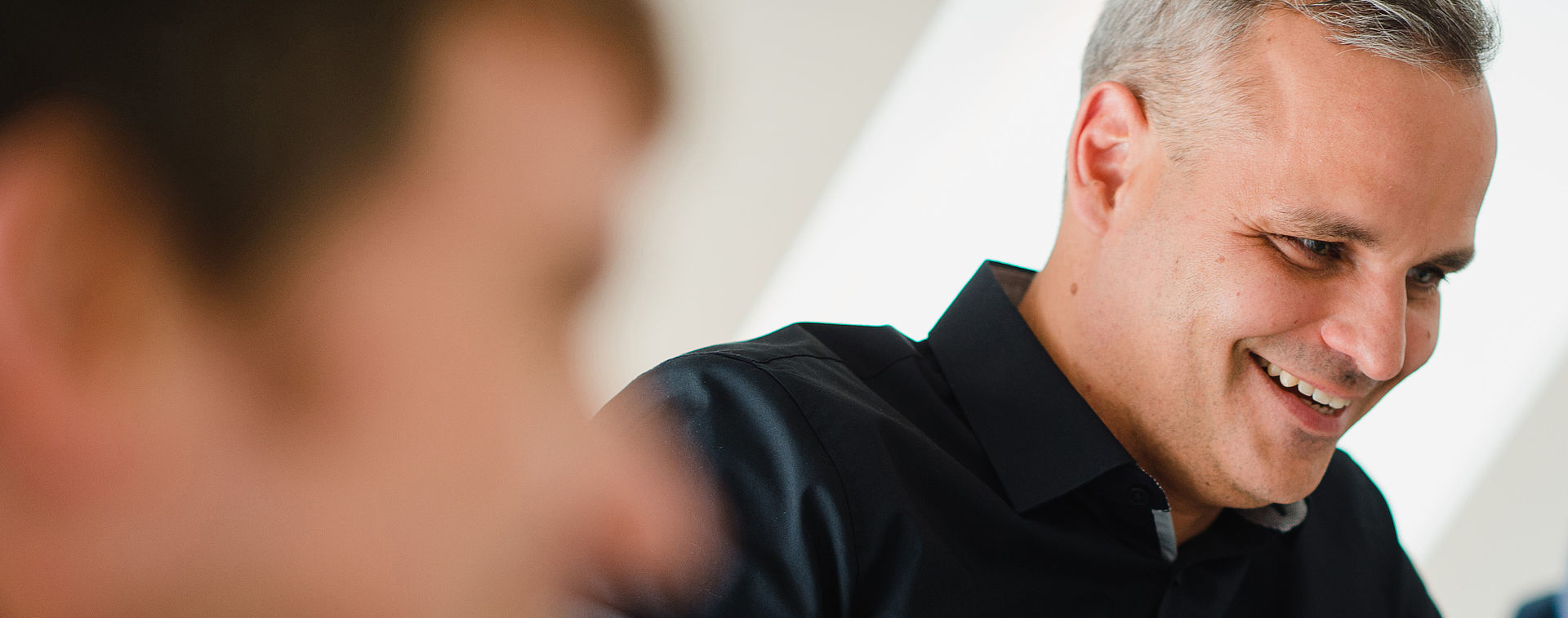Insights into our everyday work
You want to know who works at M2 and what our daily tasks and challenges are? Here you will find the answers. In our employee interviews you can read how M2 colleagues answer questions and report on their project work.

A conversation with Wolfgang Schult, Chief Architect & Technology Lead at M2
Wolfgang Schult
Chief Architect & Technology Lead for M2 since 2016
M2 Interviewer : Hi Wolfgang, first of all thank you very much for finding some time for us. To start with, of course, the most important question: What do you do at M2?
Wolfgang: As Technology Lead and as a system architect I work various projects. My job is to offer the customer different variants, for example when it comes to implementing more complex solutions. This often goes much further than just concentrating on the Tableau Software itself. I make suggestions to the customer on how best to integrate his systems into the Tableau environment and explain to him what he needs, such as databases. But I also support preceding processes in which the data is pre-processed until it is displayed in Dashboards.
M2 Interviewer : What experience have you gained in project work with customers?
Wolfgang Schult: Oh, lots! (laughs)
M2 Interviewer : Maybe you can name the ones that stand out or the ones that have shaped you the most?
Wolfgang: We have very different customers from different industries and yet many of them have more or less similar problems. This transfer service is part of the everyday "how-to", i.e. how solutions can best be implemented. It is often the case that solutions that already work for other customers can also be applied to new projects. Apart from that, you have exciting, industry-typical experiences, that's the beauty of consulting. You learn a lot of new things that are not related to the industry and are not just about technology, for example how publishers evaluate their sales figures.
"I always like to see the end users get something out of our development and see how it adds value for them."
M2 Interviewer: Was there ever a special challenge that remained in your head? Or one that "you've been chewing on"?
Wolfgang: I have to think about it... Of course, these are always special challenges, otherwise the customers wouldn't commission us. But I haven't really worked my tail off on any project. In the end, we always found a solution, often as a team. Even if you end up in a dead end at the beginning, you will find an alternative and implement it accordingly.
M2 Redaktion: At which interfaces are you connected to the customers?
Wolfgang: In principle, you work very closely with the specialist sites, which then also have specific requirements. You listen to the "worries and needs" of the departments and work out what the goal of the project is. I then transpose these requirements into the technology in my mind. You have to work very closely with the project management. As a system architect, I am also the interface to the developers. On the one hand, I understand the wishes of the customers and translate them into technical wording, which in turn must be understood by the development team.
M2 Redaktion: What does a typical working day look like from your side? For example, referring to your working day yesterday.
Wolfgang: Yesterday was really exciting. A project at a customer's site was a little off track, so we were asked if we could help. It was an important matter, because the attention of the management board was already focused on it. In the morning I spoke to the customer and discussed the problem on the phone. In between I held an internal training session.
Afterwards I returned to the customer problem, which consisted of a poorly performing Tableau Dashboard. After several discussions with the customer, we distributed the tasks internally and were able to solve the technological problem satisfactorily in the course of the evening, so that the customer finally had a functioning Dashboard.
Usually you have a lot of customer contact through telephone and video conferencing. But there are also phases in which requirements are documented or presentations are prepared. Sometimes I also implement things myself or help to prepare offers for new customers.
M2 Redaktion: That sounds like a very broad range of tasks. What drives you in your work or what attracts you the most?
Wolfgang: I'm very happy when the customer is happy and you hear from the customer "You did a great job." I always think it's nice to see when the end users get something out of our development and it adds value for them, like with our latest innovation, the M2 Form Builder. Here we have created real added value that can help many companies quickly and easily.
M2 Redaktion: How would you describe the working atmosphere at M2?
Wolfgang: Good (laughs)! It is a great team full of motivated people. You have a lot of know-how on different levels and in a wide range and it's ideal if you can benefit from each other. The regular transfer of knowledge is proactively encouraged and is expressly desired by the management.
M2 Redaktion: What do you think your field of work will look like in five years?
Wolfgang: It is of course a strongly growing and very dynamic industry. I think a lot will change in the coming years because of the topic of artificial intelligence. Many business decisions will then be made automatically by models and human-machine interaction will decrease. So much for the vision - but let's be surprised.
M2 Redaktion: Thank you for the interview, Wolfgang!
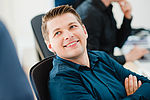
A conversation with Florian Rieger, Head of Technology at M2
Florian Rieger
Head of Technology for M2 since 2015
M2 Interviewer: Hi Florian! Great that you take some time for us. What exactly do you do at M2?
Florian: At M2 I am team leader of the "Visual Analytics" team and mainly take care of Tableau, Tableau server and d Tableau-Trainings and -Workshops. In addition, I also support the customers myself in individual projects and am specifically responsible for project management. In general, I supervise the visual and analytical areas of the projects.
M2 Interviewer : What experience have you gained in project work with customers?
Florian: It happens again and again that customers do not really understand the transformation process at first or do not know what to do with it. Often customers want to visualize their Data with Tableau and look at something specific. However, they have often not yet thought about everything that is connected with changes and efforts. This is where our consulting often just starts. We take a look at the variety of data and work out a result that fits the customer's needs.
M2 Interviewer: Was there ever a special challenge that remained in your head?
Florian: Again and again challenging are topics related to hardware or Tableau Servers. Often many small processes and procedures are more difficult than expected. Sometimes these problems must be solved quickly if they are business critical for the customer. Other major challenges are, for example, how to keep track of many Data sources without losing sight of the big picture. It is also important and challenging to take the customer along with the process so that he still understands the work steps and goals.
"What excites me is when there are very simple solutions for almost insoluble problems. I also find it great to see that the customer (...) has added value through our solution."
M2 Interviewer: At which interfaces are you connected to the customers?
Florian: As project manager, you often look at the beginning of a project together with the customer to see which steps were taken last and review them again. You analyze this and also get feedback for your own work. In addition, the next steps are planned with the customer, or the open points are defined and discussed. I also draw up comprehensive project plans with responsibilities and time management and monitor their compliance and implementation.
In the actual consulting the interface is very different. I often discuss with the customer how certain KPIs are to be defined and displayed on a dashboard. I also make requirement analyses and translate the requirements into concrete work packages and measures. This task is then again part of the project manager's work.
M2 Interviewer: What does a typical working day look like for you? For example, your day yesterday?
Florian: There is not really a typical working day for me. When I'm with the customer, we discuss the outstanding issues. The implementation of certain work steps then takes place either alone or together with my M2 colleagues, who also work on the project. Sometimes I also implement the steps directly with the customer in training sessions or workshops. For specific tasks of my own, I work through them. And like everyone here, I receive and answer many e-mails and make phone calls every day.
Since I am also a team leader, I have the task of seeing what my team members are working on and where they are at the moment. I also get an overview of what upcoming projects are in the pipeline.
M2 Interviewer: What drives you in your work or what attracts you the most?
Florian: What inspires me is when there are very simple solutions for almost unsolvable problems. I also think it's great to see that the customer gets added value from our solutiong after just a few weeksThe solutions can be very simple and already have a great impact on the customer's work. I also like the fact that we are very agile and can usually implement topics quickly, as our work is often independent of others.
M2 Interviewer: How would you describe the working atmosphere at M2?
Florian: In any case relaxed (laughs), friendly and nice. If you have to call them critical, then sometimes a little driven. But then mainly through customer projects, because we work so agile. But basically we have a great and open-minded working atmosphere.
M2 Interviewer: What do you think your field of work will look like in five years?
Florian: The professional field of the BI consultant will not look different in the future, because the digital transformation will continue for even longer. I think that this topic will continue to occupy Germany intensively in the next five to ten years. Manual and Excel-based processes will be replaced over time and it will take some time until the solutions that are offered will cover all the requirements that companies have.
My personal field of work will certainly look very different. I think that I will take on more team responsibility and less individual project implementation. I will probably also have more initial customer contacts and define work packages instead of ultimately completing them.
M2 Interviewer: Dear Florian, we thank you for the interview!

A conversation with Christoph Maurer, Visual Design Lead at M2
Christoph Maurer
Visual Design Lead at M2 since 2017
M2 Interviewer: Hello Christoph! Thanks a lot in advance for the interview with you. First of all, of course, the question, what are you doing at M2?
Christoph: I am a Data Visualization Specialist. That sounds a bit pretentious, but basically I'm responsible for visualizations,visualization, layout und grafic design. Specifically, I do template and dashboard design for tableau dashboards. This means that I find a layout and structure for the dashboards and their content. I also think about how to incorporate the CI (Corporate Identity) of the customer and finally make the visualization understandable. Concretely, one could summarize my work step like this: How do I get from the questions asked to the data to a reasonable and understandable visualization? In addition, I am responsible for the company communication. This includes flyer design, website support and whitepaper design. And every now and then I dedicate myself to the field of cultural analytics, which we use for the artistic representation of data, i.e. Data Art.
M2 Interviewer: What experience have you gained in project work with clients?
Christoph: What I always notice is that most clients find it difficult to find visual forms for the questions they ask. Often, customers see that a dashboard looks good, but they can't analyze what makes up that dashboard and can't concretely name the reasons. In short, they are not fully aware of the visual principles. And that's where I come in, to communicate these design principles to the customers and use these "rules" to implement their requirements.
"The creative moments when you try out designs and realize that some visualizations work better than others really appeal to me."
M2 Interviewer: At which interfaces are you connected to the customers?
Christoph: I am often involved in the work at the beginning of a project. It is discussed what exactly is to be visualized and I make the first sketches ("mockups"). With the help of these sketches you can already estimate what information you need and the visualization becomes very tangible for the customer. The mockups are created by me before the dashboards are built.
M2 Interviewer: What does a typical working day look like from your side?
Christoph: Come in in the morning, make coffee, ... (laughs). No, so a typical working day, that's difficult. I usually come into the office in Prenzlauer Berg in the morning and have a lot of contact with the staff. I talk to the customers less because other employees are in contact with the customer. Together with the employees of M2, I develop the mockups, which they then give to the customer. In the office I develop the designs in cycles and consult with the project managers.Sometimes I also give trainings on visual design. Visual Design. Dieses Gebiet bauen wir aktuell weiter aus. Es gibt nun neben unseren Standard-Tableau-Trainings auch einen two-day data visualization Workshop, in which participants learn how to use visualizations correctly and how to design a dashboard in conformity with CI.
M2 Interviewer: Why don't you give us another brief insight - what did your working day look like yesterday, for example?
Christoph: Yesterday I had a few meetings and had to prepare a presentation for a client who wanted to have a re-design of a dashboard which should now look "sexy" (laughs). I get this request very often.
M2 Interviewer: And do you know how you are going to implement this?
Christoph: It's a table, that doesn't make it easy. But I already have an idea, so we'll find a good solution for this as well (laughs).
M2 Interviewer: What drives you in your work or what attracts you the most?
Christoph: That's already the whole topic of visualization. Often I'm not even clear about what the final result will look like. But the creative moments, when you try out designs and notice that some visualizations work better than others, really appeal to me. But I also love moments of insight, where you get interesting insights into data structures that you didn't have before.
M2 Interviewer: How would you describe the working atmosphere at M2?
Christoph: Very pleasant, collegial and determined by flat hierarchies. My superiors work very close to me and this circumstance makes the atmosphere very personal.
M2 Interviewer: Let's take a look into the future. What do you think your professional field will look like in five years?
Christoph: Visualization will become more and more important and other aspects will be added, like machine learning. But the visual field will always remain and will become even more important. So in combination with machine learning it will still be the

